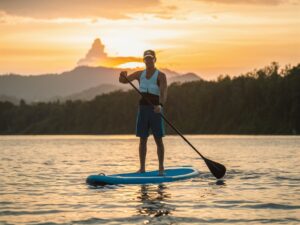
Paddleboarding has become a beloved pastime for many, offering a perfect blend of relaxation and adventure on the water. However, to ensure a smooth and enjoyable experience, it’s crucial to have the right gear in your arsenal. Let’s go through the must-have equipment for beginner paddle boarders, helping you gear up for your next aquatic adventure.
Paddle Board
Let’s start with the star of the show – the paddle board itself. As a beginner, you’ll want to consider whether an inflatable or rigid board best suits your needs. Inflatable boards are typically more portable and easier to store, making them ideal for beginners or those with limited storage space. Check out this page to view beginner paddle boards, including inflatable designs. On the other hand, rigid boards offer greater stability and performance, making them a solid choice for those looking to advance their skills. Whichever you choose, be sure to consider factors such as size, stability, and weight capacity to find the perfect board for you.
Paddle
Next up, let’s talk about the paddle – your trusty companion on the water. Choosing the right paddle length is crucial for efficient paddling and preventing strain on your body. As a general rule, the paddle should be approximately 8-10 inches taller than you for optimal performance. Additionally, consider the material and blade shape of the paddle. Carbon or fibreglass paddles are lightweight and durable, while nylon blades offer affordability without sacrificing quality.
Personal Flotation Device (PFD)
Safety first, folks! A personal flotation device, or PFD, is a non-negotiable item for paddle boarding – especially for beginners. While you may be confident in your swimming abilities, unexpected situations can arise on the water. A PFD provides an extra layer of safety and buoyancy, giving you peace of mind as you explore the open waters. Choose a PFD that is comfortable to wear and meets safety standards for water sports.
Sun Protection
Speaking of sun protection, don’t forget to lather up before hitting the water. Sunscreen is your best defence against sunburn and skin damage, so be sure to apply a generous amount to exposed skin before heading out. Don’t forget to protect your eyes and face with a wide-brimmed hat and polarised sunglasses. And remember, reapply sunscreen regularly, especially if you’ll be out on the water for an extended period.
Waterproof Bag or Dry Bag
Keep your belongings safe and dry with a waterproof bag or dry bag. Whether you’re carrying snacks, electronics, or a change of clothes, a waterproof bag ensures your essentials stay protected from water damage. Look for a bag with a secure closure and durable construction to withstand the rigours of outdoor adventures. Bonus points, if it’s buoyant or designed to float, giving you, added peace of mind in case of an accidental spill.
When Should You Kneel on a Paddle Board?
Have you always assumed that you have to stand on a paddle board? While this is a popular way to enjoy this activity on the water, there are many others that choose to kneel instead. Indeed, this can be a comfortable and reassuring way to enjoy paddle boarding if you’re a beginner, and it can be a good way to cope with changing conditions. Let’s take a closer look at the scenarios where kneeling on a paddle board is going to be advantageous.
When You Are a Beginner
Getting onto a paddle board can be daunting for those who are new to the activity. You might worry that you can’t keep your balance and end up falling into the water. Well, this is a situation where you want to kneel on the board. It’s going to help you tremendously since you’ll find it easier to balance. You can get used to paddleboarding this way first before you gain the confidence to stand up. Therefore, if you’re a beginner and are nervous, consider kneeling first.
When It Is Windy
If you’ve ever tried to paddleboard when it’s windy outside, you’ll know that it takes a lot more effort. Indeed, you need strength to battle the wind on the water. For some people, this can be too much, and you can get exhausted, especially if the water is choppy at the same time. So, to make things easier for you, you can kneel on the board. Since you’ve got more stability, you can find it easier to gain strength for paddling. You can feel like you have a lot more control over the situation.
When You Are Tired
If you’ve been out on the water for a while, you ca get very tired standing up. This is particularly true if you’ve been battling the elements or the water has been choppy. Instead of having to get off the board and take a break, you can adapt the way you’re enjoying this activity. Instead of standing, you can kneel on the board. This is going to allow you to rest but still keep moving. Once you’ve regained some of your energy from this position, you can go back to standing.
Conclusion
And there you have it – the top essential gear for beginner paddle boarders. By investing in the right equipment, you’ll be well-prepared to embark on your paddle-boarding journey with confidence and peace of mind. Whether you’re cruising calm lakes or riding waves along the coast, having the proper gear ensures a safe and enjoyable experience on the water.
